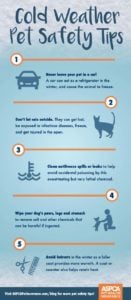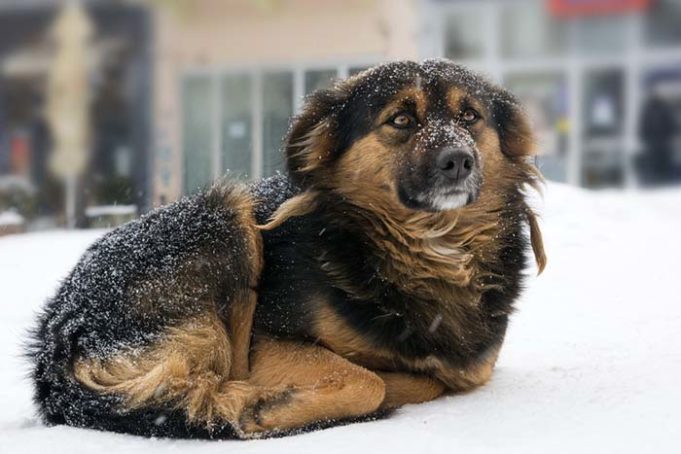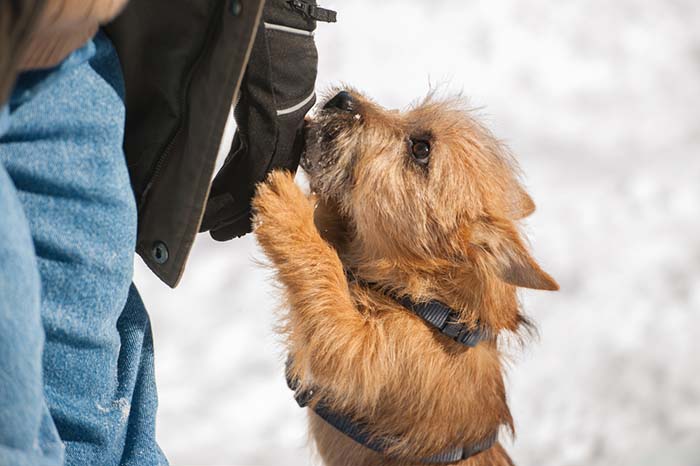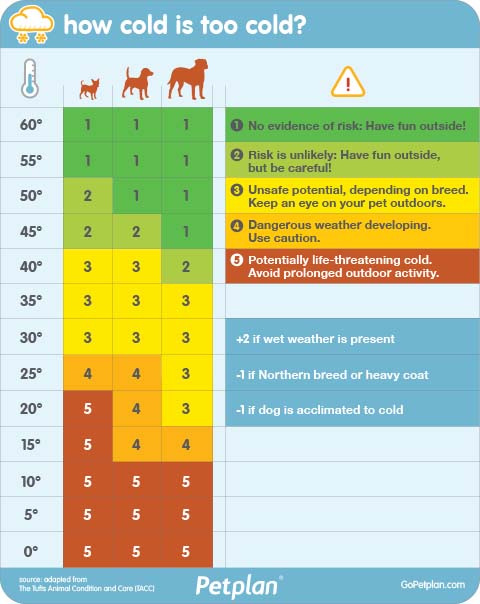Dogs need exercise and mental stimulation to be healthy, and this is best done outdoors – walking, training, playing. However, it's now the middle of October and if you live somewhere where it's becoming increasingly cold, you expect snow, ice and low temperatures, you may be concerned when is it too cold for dogs. So how do you tell when your pooch is cold? It depends.
 Not all dogs are created equal. A temperature that feels comfortable to one dog might send another dog searching for a warm shelter. Some breeds like Siberian Huskies or Alaskan Malamutes are great for sustaining very cold weather conditions, but no current domesticated breed will handle extremely cold weather for a prolonged period of time.
Not all dogs are created equal. A temperature that feels comfortable to one dog might send another dog searching for a warm shelter. Some breeds like Siberian Huskies or Alaskan Malamutes are great for sustaining very cold weather conditions, but no current domesticated breed will handle extremely cold weather for a prolonged period of time.
Just like us, dogs can get cold and develop health problems if they aren't taken care of. There are a few ways to know when is it too cold for dogs. Consider the following if you're going outdoors with your dog in winter time and you're concerned how your dog might react to cold weather conditions.
ALSO READ: 9 Safety Tips for Walking Dogs In Winter
When Is It Too Cold for Dogs?
Consider Your Dog's Situation…
If you're trying to determine when is it too cold for dogs to be outside in winter time, there are two areas to consider – your dog's personal situation, and the environmental factors. Here's what you need to consider for your pooch:
1. Coat Color
On clear, cold days, dogs with brown, black, or other dark colored coats are able to keep themselves warmer than dogs with light coats. This only works on days when the sun is out because as we already know, darker colored coats on dogs are able to absorb more heat from the sunlight.
2. Coat Type
Dogs with thick, multi-layered coats are able to withstand colder temperatures. Examples include the obvious Alaskan Malamutes and Siberian Huskies. Aside from their coat, these dogs are usually bred in Northern climates, which gives them genetic, behavioral, and physiological attributes and advantages that allows them to thrive in colder weather conditions. Dogs with thin coats, such as Greyhounds, will suffer much more from cold during the winter as they struggle to keep themselves warm for prolonged periods.
3. Weight and Body Fat
 Body fat insulates dogs from cold weather, so bigger dogs usually have easier time in low temperatures. Thin and underweight dogs will have a harder time dealing with cold weather. It goes without saying that you should never attempt to make your dog gain weight for the winter, or during the winter, just to protect them from the cold. The disadvantages of overweight dogs and obesity are far greater.
Body fat insulates dogs from cold weather, so bigger dogs usually have easier time in low temperatures. Thin and underweight dogs will have a harder time dealing with cold weather. It goes without saying that you should never attempt to make your dog gain weight for the winter, or during the winter, just to protect them from the cold. The disadvantages of overweight dogs and obesity are far greater.
4. Size
Similarly to the weight and body fat level, the overall size of the dog matters in how well he'll be able to sustain cold temperatures. Small dogs get cold much quicker than larger dogs because small dogs simply have a bigger surface to volume ratio. What this means is small dogs have more skin to lose heat through. Teacup dog breeds should never be in cold temperatures for a long periods of time without proper clothing and protection.
5. Age and Current Health
Healthy dogs in the adult age range are able to regulate their body temperature fairly well and will not suffer from as many consequences as other dogs may suffer. Young dogs and puppies, old senior dogs, and dogs with health problems such as arthritis will have more issues regulating their body temperature, and will suffer through cold weather much worse as a result.
Veterinarians generally recommend to keeps pets inside most of the time during winter if they have any health problems, and especially arthritis:
“In general, pets with health conditions are better as indoor pets so their health can be monitored closely,” – says Dr. Sarah Griffin, DVM (source)
6. Conditioning
Simple conditioning for specific temperatures is one of the most important factors. When a dog is used to cold temperatures, they are able to handle the temperature much easier. A dog from California will have a much harder time in a cold winter than a dog from Alaska. Also, when winter first begins, your dog will probably have a harder time adjusting to the weather. Later on in the winter, most dogs will be able to handle it a bit easier.
RELATED: 9 Tips on How to Protect Your Dog's Paws in Winter
Consider the environment…
Your dog's body type and health condition aren't the only factors to consider when trying to assess when is it too cold for dogs. If you aren’t sure if it is okay for your pooch to be outside in winter, remember that the temperature itself isn’t the only factor that controls how it really feels outside. Consider the following:
7. Dampness
Any form of dampness that soaks through a dog’s fur will cause them to quickly feel cold, even if it isn’t actually all that cold out. Rain, snow, and fog are all weather conditions that can make a dog feel colder than the temperature. Even if you’re just taking your dog for a swim (which probably isn't recommended in winter), they can become very cold very fast.
8. Wind Chill
 Breezes cut through a dog’s coat. This decreases your dog’s ability to insulate themselves and protect against cold temperatures. Wind chill is a very important factor when assessing when is it too cold for dogs in winter.
Breezes cut through a dog’s coat. This decreases your dog’s ability to insulate themselves and protect against cold temperatures. Wind chill is a very important factor when assessing when is it too cold for dogs in winter.
National Weather Service has a great and accurate wind chill chart called Wind Chill Temperature (WCT) index that shows the dangers of this weather condition and how to assess it.
9. Activity
If your dog is going to be active while outside, they might be able to generate enough body heat to keep themselves warm, even in cold conditions. That said, constant movement is required during extremely low temperatures so it's best to avoid sitting around with your dog doing nothing when he doesn't have any protective clothing. Even if you have an active dog, avoid leaving them alone outdoors during very cold days.
10. Cloud Cover
Final consideration when assess when it is too cold for dogs in winter is how cloudy the day is. Dogs that do not have any access to heat source or any protective winter clothing can only use the sun as their single source of warmth to absorb heat and keep themselves warm. As mentioned above, the darker your dog's coat, the more heat he'll be able to absorb. However, when it is cloudy outside and there's no sunlight, dogs aren’t able to do this and will ultimately feel colder as a result.
In Summary
Most of the time, temperatures do not become an issue for dogs until it falls below a certain degree. Canine experts and veterinarians warn pet owners that once temperatures are below 45 F degrees, some dogs may begin to feel uncomfortable and may need to be warmed up soon. When temperatures are below 32 F degrees, certain dogs could have problems outside and are close to a dangerous territory.
 When trying to assess when it is too cold for dogs, your canine's personal situation is very important. If your dog is older, a puppy, small, has a thin coat, or has a health problem, you should pay close attention to his cold tolerance and watch for any signs of discomfort.
When trying to assess when it is too cold for dogs, your canine's personal situation is very important. If your dog is older, a puppy, small, has a thin coat, or has a health problem, you should pay close attention to his cold tolerance and watch for any signs of discomfort.
If you see any, bring your dog inside to warm up. If temperatures hit 20 F degrees or lower, all dog owners need to pay attention to their dog for discomfort and generally avoid the outside. Problems such as hypothermia and frostbite become a risk, which can be deadly if ignored.
If you're already worried when is it too cold for dogs, then remember the general rule: if it is too cold for you to be outside, it is too cold for your dog as well. If you are outside with a coat on and still feel cold, your dog definitely feels cold and probably needs a dog coat of his own, or needs to be brought inside.
“It’s a common belief that dogs and cats are resistant than people to cold weather because of their fur, but it’s untrue. Like people, cats and dogs are susceptible to frostbite and hypothermia and should be kept inside.” – American Veterinary Medical Association
Dogs should never be left alone outside during cold weather conditions, especially if temperatures are below 20 degrees. If you absolutely must leave your dog outside, be sure to provide some kind of warm shelter for them. A well insulated dog house with lots of blankets could work, and especially if there's a dog house heater inside. Even so, it is still risky, so you should bring them inside as soon as you have the chance.
When you are trying to determine when is it too cold for dogs to be outside, make sure you understand your dog's situation. Know their coat type, their age, and their health. Make sure you know if they are used to cold temperatures. When your dog is outside, look for any potential signs of discomfort. If they seem uncomfortable, bring them inside to warm up immediately. Doing this can keep your dog comfortable, and possibly save them from hypothermia or frostbite.
READ NEXT: What’s the Best Ice Melt Safe for Pets?
















